Calling the Shots

LOCUST VALLEY, N.Y. — Here, on the manicured campus of a Quaker school in central Long Island, a sleepy Thursday afternoon comes alive moments after the opening kickoff of a football game. Cyrus Holder, a wideout at Friends Academy, collects the end-over-end kick, evades a few would-be tacklers and bolts down the left sideline.
“Go Cy, go!” the head coach shouts.
Holder slips through a scrum and sprints toward open field.
“Wooo!” the quarterback hollers.
Touchdown: 80 yards.
The home sideline erupts, everyone roaring and fist-pumping and jumping up and down. Everyone, that is, except the offensive coordinator. He coolly raises his right hand and extends his index and middle fingers, letting everyone know they’re going for two. Moments later, a sweep right makes it 8-0. As the cheering resumes, the coordinator glances down at his play-call sheet and can’t help but crack a slight grin.
Boomer and Gunnar appeared on the cover of Sports Illustrated in October 1993 to raise awareness about cystic fibrosis. Gunnar, 23, is now the offensive coordinator for Friends Academy, where he played high school football in Long Island. (Michael O'Neill /Sports Illustrated)

America has seen that smile before.
It belongs to Gunnar Esiason, son of Boomer, who in October 1993 appeared on the cover of Sports Illustrated as a 2½-year-old with honey butter blonde hair and Chiclet teeth. Swimming in an oversized Jets jersey, he sat on his father’s shoulders, both of them smiling above the headline: “A Quarterback’s Crusade: Boomer Esiason and his son, Gunnar, battle a deadly disease.”
Since before he could talk, Gunnar has lived with cystic fibrosis, a rare genetic disorder that causes the lungs to fill with mucus. “Imagine having bronchitis,” he says. “All day, every day.” When he was diagnosed, life expectancy ranged from the late teens to the mid-20s. But look at him all grown up. The blonde locks have morphed into shaggy brown curls, and he’s now a 23-year-old high school football coach who is impossible to miss, standing almost as tall as Boomer at 6’ 3”.
Coaching football never was part of Gunnar’s master plan, and the growing pains he’s endured the past season and a half will be reinforced this afternoon: The two-point conversion is Friends’ last highlight in what will be a 34-8 loss to Clark High School from nearby Westbury. But at that moment, his two fingers held skyward in the crisp October air, Gunnar Esiason’s confidence is so unmistakable that you forget about the battle he’s still waging.
* * *
Gunnar is an excellent writer. An English major at Boston College, he keeps an enlightening, and candid, blog about living with CF. “When I’m not feeling so hot, like this past week, my mucus feels like yogurt,” he wrote in August. In another post, he published a selfie in which his shirt is lifted to reveal an abdomen marked by surgical scars and tubing inserted above the navel. The “G-Tube,” which can give him up to 5,000 calories a day, is a relatively new gadget that Gunnar picked up two years ago after a bout with pancreatitis. “If I took my shirt off, unfortunately you wouldn’t see a chiseled movie star’s body,” he wrote on July 8. “I’m not really looking like the guys from 300 these days.”
Twice a day, after waking up and before going to sleep, Gunnar straps on a black vest that looks like a life preserver to give himself two-hour steam mist treatments to open his lungs. His doctors aren’t thrilled about him coaching. They haven’t banned it, but being around kids isn’t ideal, especially during cold and flu season. Gunnar also coaches hockey at Friends Academy, and he doesn’t get home until 10 p.m. on nights when he goes to the rink.
“I could literally be sitting on my couch all day just waiting to do treatments, or I could be going out and living my life,” says Gunnar. “Which would you pick?”
“We want Gunnar to find a beautiful girl, to get married, have his own family,” Boomer says. “The reality is that there are going to be significant fights ahead.”
The oldest of the Esiasons’ two children—sister Sydney is a senior at BC—Gunnar keeps living the way he always has: doing what he wants, but with precautions. He sometimes wears a surgical mask in the football team’s germ-infested locker room, and sometimes would be always if his mom, Cheryl, got her way. He sometimes ditches the team bus and drives his car to away games; he carries prescription hand sanitizer everywhere.
“I forget about everything he’s going through because he just seems so normal,” says Corey Goldglit, the starting quarterback at Friends. “Then he’ll have this big cough, or he’ll have to spit out phlegm, and it’s like, ‘Oh, right.’ ”
A CF patient’s immune system is inherently weak, so even a common cold can cause major complications. The summer of 2013 was especially bad for Gunnar, who had just graduated from BC and was hoping to go to law school. But he kept shuffling in and out of the hospital as doctors kept injecting IV after IV trying to figure out why he couldn’t stay hydrated or maintain his weight. After two months of treatment, he was in no shape to study for the LSATs.
As his strength returned, Gunnar became like most recent grads, living at home and trying to find a direction. Then his high school called. “We had an opening,” Friends athletic director Alan Quackenbush says. “And adding Gunnar felt like a natural fit.”
Gunnar had coached youth hockey before, and he had a knack with kids. One of his players was the son of four-time NHL all-star and current Islanders assistant coach Doug Weight, who was so impressed with Gunnar that he asked him to coach his son’s travel team, too. Football, though, was a new venture.
Gunnar wasn’t worried about forming relationships with players—his age automatically qualifies him for a cool-big-brother role—but he wanted to brush up on the X’s and O’s. Gunnar had been the backup quarterback at Friends; catching a bug sidelined him a few times, but he otherwise played with no limitations. (A favorite story Quackenbush likes to tell: After sprinting during a particularly humid preseason practice, one player gasped for air. Gunnar turned to his teammate and quipped, “Now you know how I feel every day.”)
On top of playing hockey throughout his childhood, Gunnar played lacrosse and football at Friends Academy. (John Iacono/Sports Illustrated :: Courtesy photo from the Esiasons)

“I’ve always loved being a part of a team,” Gunnar says. “Unfortunately I wasn’t given the body to be a super athlete.” And so a reliable teammate strived to be a remarkable coach.
Gunnar fell in love with the offense Colin Kaepernick was running with the 49ers. “That’s what I wanted to emulate,” he says. But he quickly realized that San Francisco’s read-option and blocking schemes might be too complex, so he scrolled back to Kaepernick’s college career. “I can’t tell you how many hours I spent watching YouTube videos of Nevada,” he says. “Hours upon hours upon hours.”
Gunnar copied the plays, verbatim, and implemented them at Friends. But execution was a whole other issue. “Plays can always work on paper,” says head coach Ron Baskind, now in his 28th season. “But you have to make them work on people—and with kids, you never know what you’re going to get.”
“I’d come home so frustrated,” Gunnar says. “Why can’t they figure it out? My dad was like, ‘Well, now you see how coaches feel in the NFL when the players are getting paid and they still don’t get it.”
To help Gunnar regroup, Boomer pulled out his Bengals playbooks from 1988—they were literally dusty—and together they began flipping through the pages. Boomer was league MVP that season, throwing for 3,572 yards and 28 touchdowns. It was the year the Ickey Shuffle became a pop-culture sensation, and the year the Bengals’ quick-passing, no-huddle offense terrorized defenses to the tune of a 12-4 record and a Super Bowl berth. To Gunnar, all the plays looked like a bunch of gibberish.
“I had no idea what I was looking at,” he says. “So I had to decipher it, simplify it and translate it to high school.”
Gunnar gave a traditional Power-I offense a touch of the modern by implementing the pistol formation, among other wrinkles. (Taylor Ballantyne/The MMQB)

Friends Academy, for as long as anyone can remember, has relied on the Power-I. “It’s a great tradition,” Gunnar says. “But when I joined the staff last season, I tried to add a new wrinkle.” And so his play-call sheet is sprinkled with ambition: the pistol formation, short West Coast-style passes, and plays taken straight from his four-time Pro Bowl father’s NFL playbooks. The biggest challenge was teaching it to teenagers, which meant simplifying the terminology.
“A play in their book was crazy numbers and words, literally like a whole sentence,” Gunnar says. “I made ours easy. The routes are even in the name of our play.” One play, for example, is called Spread Right Layers. It’s a four-wide receiver set with two layers of routes—the deepest being a post route to the right.
Gunnar also minimized personnel groups. Actually, there’s really only one personnel group. Because of the school’s size (roughly 95 students per grade) only 22 players dressed for last Thursday’s game. A handful suffered injuries during the game, and by the fourth quarter only four weren’t playing every down—offense, defense and special teams. “We make do with what we have,” Gunnar says.
With patience and revised expectations, Friends Academy has made it work. A few weeks ago, Gunnar noticed an opponent was only covering his top receiver. “It was kind of idiotic,” he says. So he called an audible from the sideline. A quick two-yard slant became a deep ball that Goldglit threw for a 65-yard touchdown. The play had hints of Boomer: a bit of improvisation, a bit of magic, a bomb of a throw.
“Any time one of my plays work, it’s the best feeling,” Gunnar says. “It’s like, I did that?”
Entering last Thursday’s game, Goldglit was the leading passer in the county and Holder, the junior who ran back the opening kickoff, was the leading receiver.
“I knew Gunnar would be impacted positively by the whole experience, I didn’t realize it would totally engulf him,” Boomer says. “But if you know coaches, once they get into it, and have some success with it and see the kids are responding—it’s addictive. He’s in his second year of coaching and he’s insane about it.
“It’s a wonderfully inspiring story. But it’s also a painful and frustrating story because you have to remember what he’s dealing with.”
* * *
Calling the Shots
Gunnar and Boomer in the Jets’ locker room in 1993. (Michael O'Neill/Sports Illustrated)
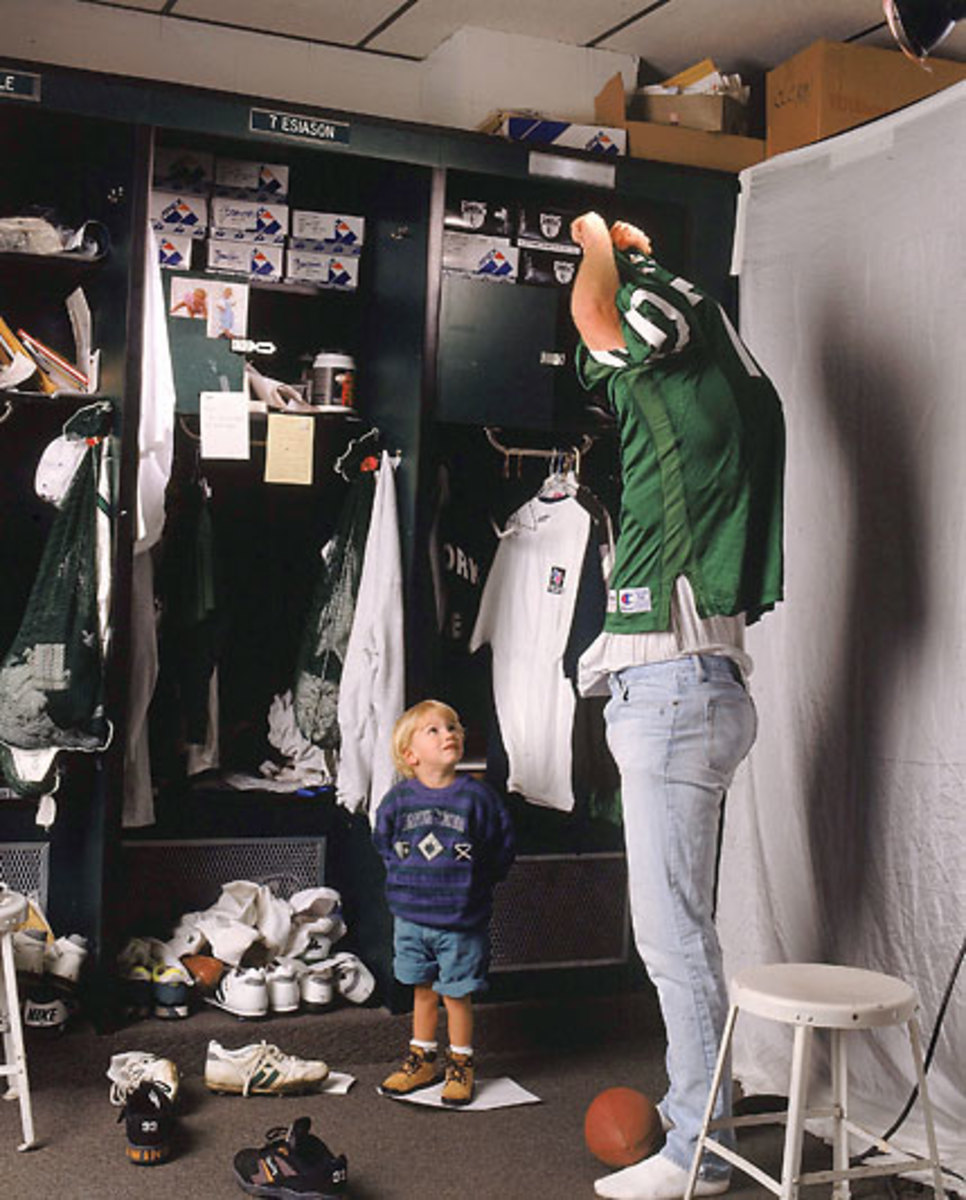
Gunnar giving dad a kiss during the same SI photo shoot. (Michael O'Neill/Sports Illustrated)
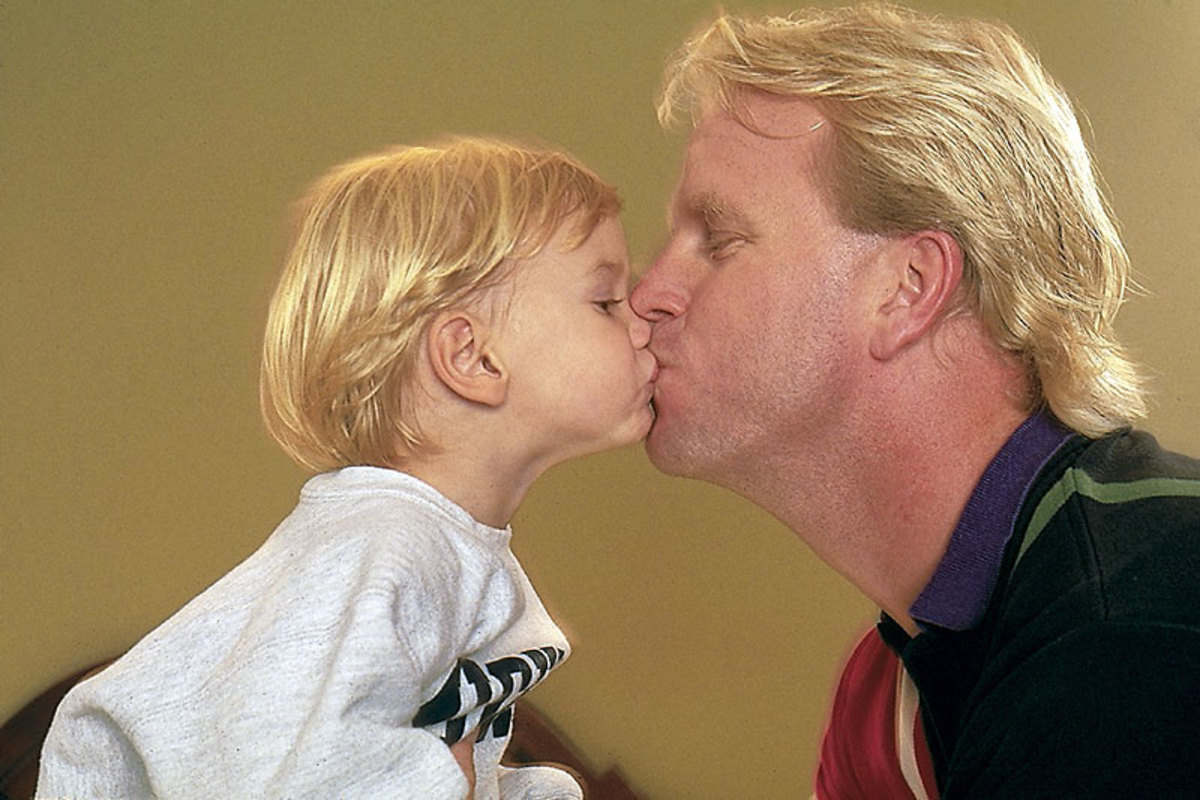
And recreating their cover shot pose throughout the years. (Manny Milan and Michael O'Neill/Sports Illustrated)
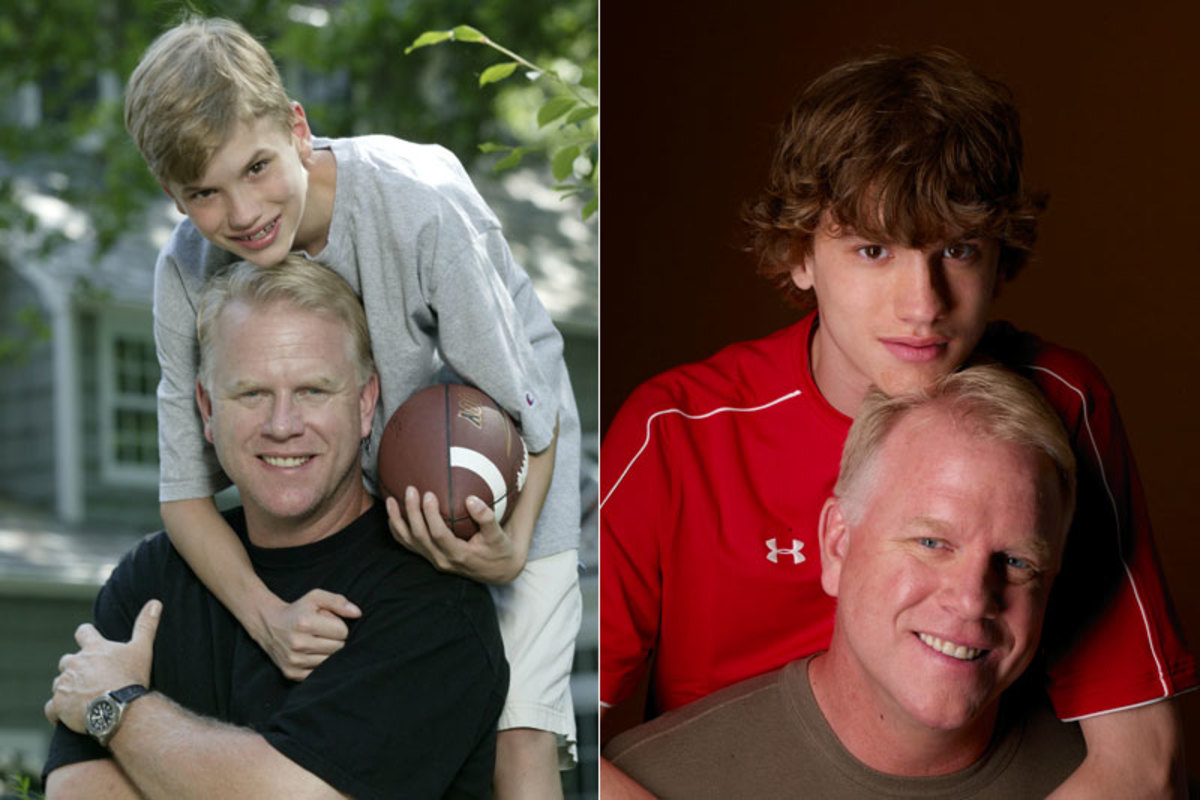
Gunnar celebrating a play in the NYC vs. Long Island all-star game to benefit cystic fibrosis research, and running the offense at Friends Academy. (Courtesy photos from Michael P. Damm Jr.)
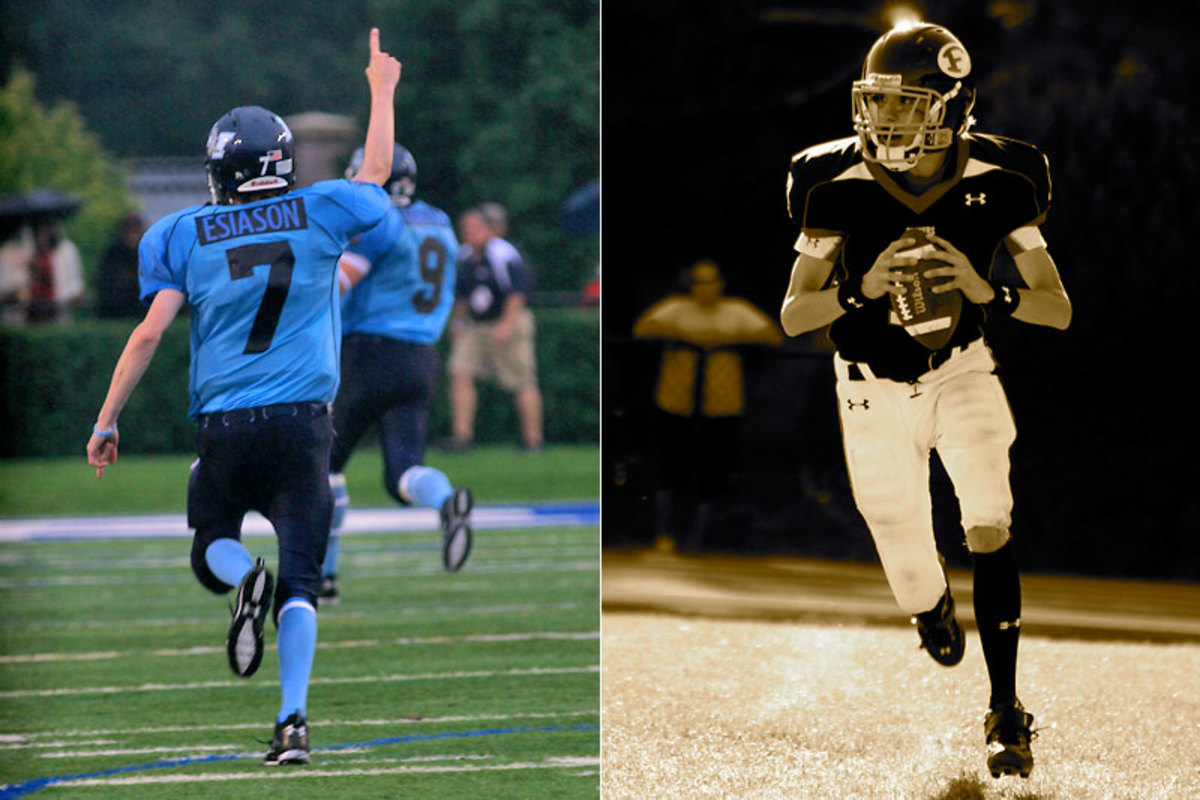
Gunnar sending in a play during last Thursday’s game. (Taylor Ballantyne/The MMQB)
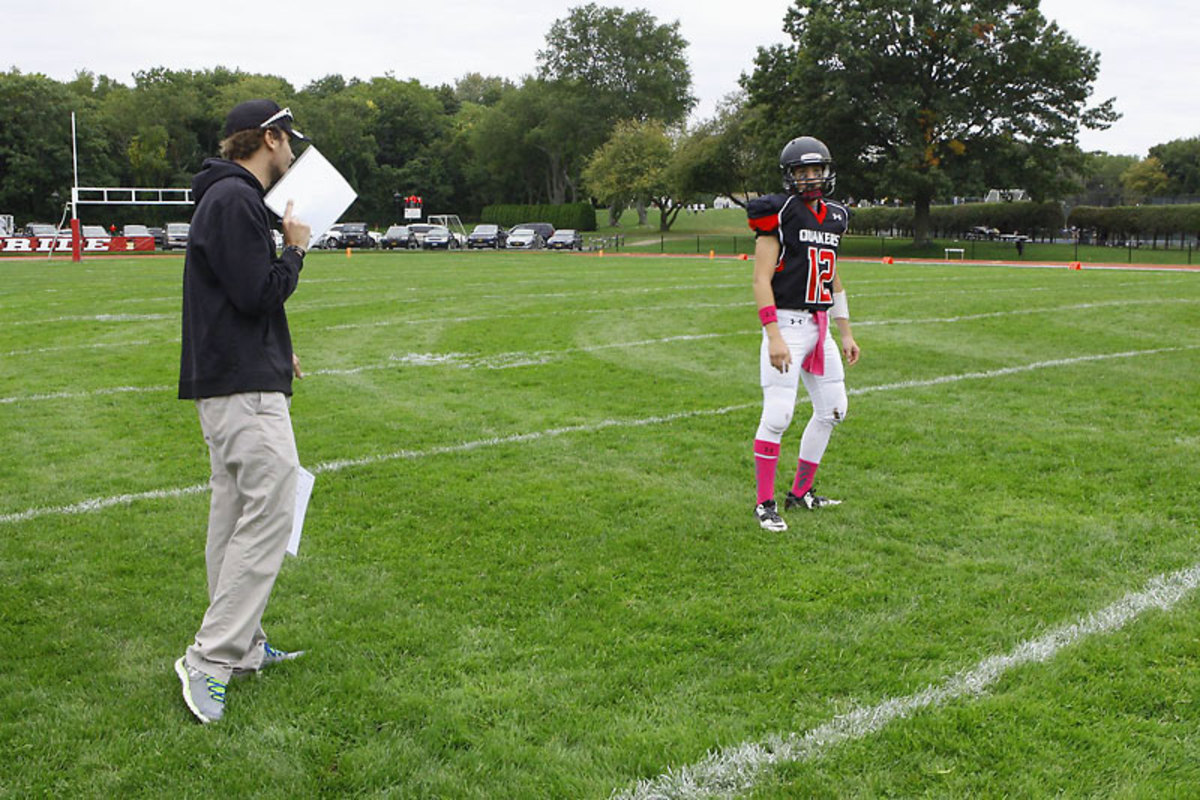
After waking up and before going to sleep, Gunnar gives himself two-hour mist treatments to help open up his lungs. (Taylor Ballantyne/The MMQB)
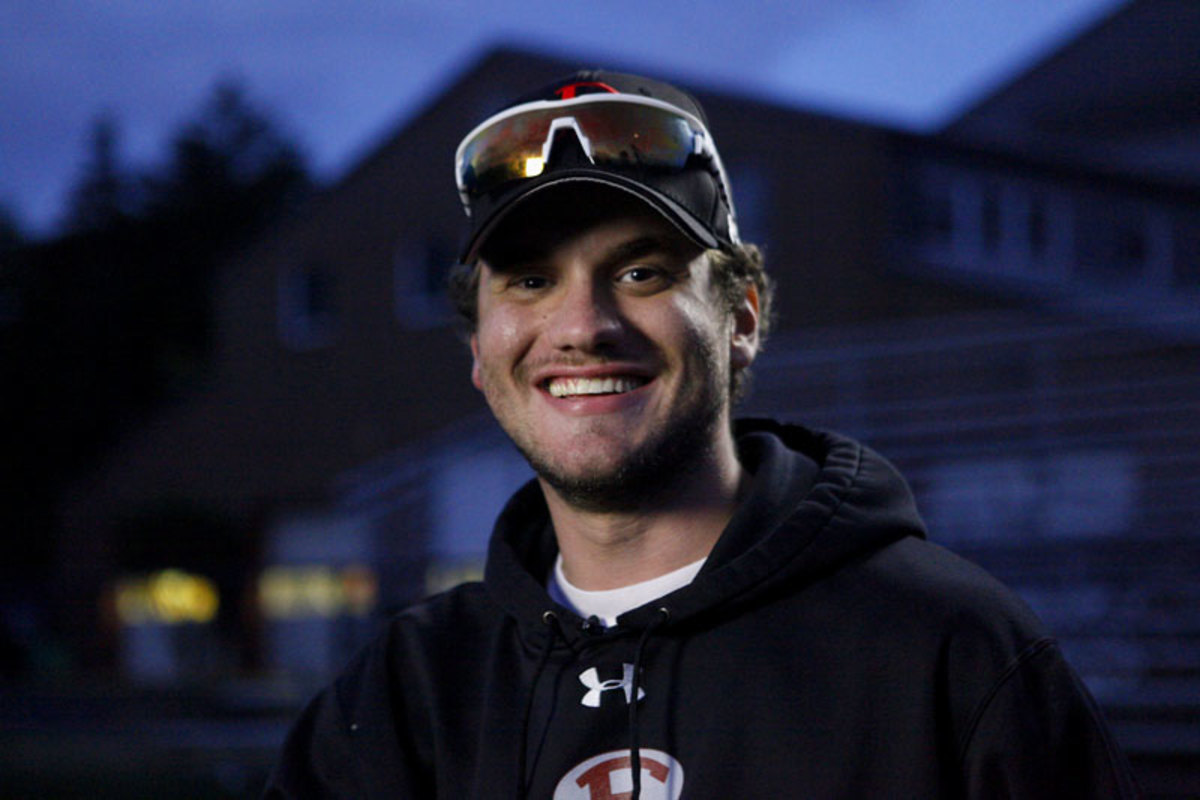
Sports Illustrated has checked in on the Esiasons over the years, as the family’s foundation grew (it has raised more than $100 million for CF research), as Gunnar reached adolescent milestones (he threw two varsity touchdowns), and as science progressed (the average lifespan for CF patients who reach adulthood is now 37).
If you didn’t know about Gunnar’s battle with CF, he’d strike you as just a regular guy. He has a disarmingly affable personality, answering a reporter’s cold call with a warm “Hey there! What’s going on?” He keeps his facial hair scruffy; he loves his Raptor Truck; he adores his mom’s mashed potatoes; he tweets pop culture references—@G17Esiason: I want to make a Lorde joke because the Royals won... But I'm still upset about her taking the rock category at whatever award show that was—and he plays in a weekend hockey league with his father. “We can’t play on the same line anymore,” Boomer says. “Our styles are way to different. I yelled at him too much.”
It’s a strange thing, asking a 23-year-old about his mortality. But Gunnar understands that life with CF is tenuous. Sitting on a bench after the game, he ponders his fate for the briefest of moments.
The Esiasons have always stressed a carpe diem attitude, a philosophy of understanding that Gunnar has cystic fibrosis but not letting CF define him. “What I want for him is what every parent wants for their kid, but maybe even more so,” Boomer says. “We want Gunnar to find a beautiful girl, to get married, have his own family. He’ll be a great dad—he’ll be an insane dad. The reality is that there are going to be significant fights ahead. We never really verbalize it, but we know it.”
It’s a strange thing, asking a 23-year-old about his mortality. But Gunnar understands that life with CF is tenuous. Sitting on a bench after the game, he ponders his fate for the briefest of moments. How long will you live? You can tell he has considered this question before, only to drop the whole thing and let it be. “Really, I have no idea,” he says, speaking with no emotion and perfect clarity. “I don't even know what my life expectancy is supposed to be now. If you think about things like that, that’s when you lose yourself. Every day I wake up, every day I can live is a victory.”
It puts the football losses in perspective. Goldglit was among the players lost to injury last Thursday, and losing his starting quarterback limited Gunnar’s creativity and the team’s ability to execute. The Quakers fell to 1-4. But there was Gunnar an hour after the final whistle, chatting with Goldglit’s parents and throwing his arm around Godlelit as he joked about the quarterback’s pink socks.
“The two of them text all the time,” Goldglit’s mom, Lisa, says. “They think it’s all about football. I know they are both getting so much more out of it.”
On the field, Gunnar is an easy-going, personable coach. But the CF patient who wakes up every morning isn’t as composed. Bacteria swarm in his lungs all night. He’s disheveled, headachy and has a throat full of phlegm. He has to find the strength to get up, to strap on his vest and to take on the day.
The best part of it, no doubt, is football practice.

[widget widget_name="SI Newsletter Widget”]
